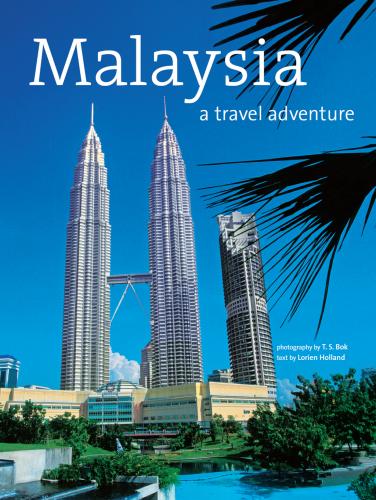Chinese immigrants brought many traditions with them to Malaysia, including female foot binding for richer women in their community. Although foot binding is no longer practised, replicas of the diminutive brocade shoes can still be found in craft shops and museums.
Dressed in traditional costume, this young woman helps celebrate Malaysia’s remarkable cultural diversity in its annual “Citrawarna“ (Colours of Malaysia) parade.
Fireworks over the old Moorish-style law courts bordering Dataran Merdeka (Independence Square) in downtown Kuala Lumpur, heart of the colonial administration in Malaya.
Malaysia
a travel adventure
photography by Bok Tai Siew
text by Lorien Holland
Contents
Malaysia: The Original Melting Pot
Kuala Lumpur and the Hill Stations
Penang and Langkawi: The Western Islands
Malacca: Historic Trading Centre
Kelantan and Terengganu: The Malay Heartlands:
A runner on the jogging track outside the state-of-the-art Petronas Twin Towers in the Golden Triangle business district of Kuala Lumpur. Below right: The white sands and palm trees of Sipidan Water Village Resort in the eastern state of Sabah are deliciously inviting. Top right: All hotels and dive operators were evicted from the world-renowned Sipidan dive site in 2005 in order to preserve its unique environment, and divers are now accommodated in romantic stilt villages like the Sipidan-Kapalai Resort. Right: Until Malaysia’s highway network got off the ground in the 1970s, Kuala Lumpur’s old railway station, designed in Moorish style by a British colonial architect, was the centre of activity.
Published by Periplus Editions with editorial offices at 61 Tai Seng Avenue, #02-12 Singapore 534167.
Copyright © 2007 Periplus Editions (HK) Ltd
Photographs © 2007 Bok Tai Siew
All rights reserved. No part of this publication may be reproduced or utilized in any form or by any means, electronic or mechanical, including photocopying, recording, or by any information storage and retrieval system, without prior written permission from the publisher.
ISBN: 978-1-4629-0929-2 (ebook)
Printed in Singapore
Photo Credits
All photos by Bok Tai Siew except for the following: C. K. Ng: pages 85 (below left and right), 91 (below), 94; S. G. Tan: page 107; A. T. Tang: page 52 (above); Ricky Teoh: pages 56 (below), 78 (below), 100, 102, 103 (above), 104 (below left).
Distributed by
Asia
Berkeley Books Pte Ltd
61 Tai Seng Avenue, #02-12 Singapore 534167
Tel: (65) 6280-1330; Fax (65) 6280-6290
Indonesia
PT Java Books Indonesia
Kawasan Industri Pulogadung Jl. Rawa Gelam IV No. 9, Jakarta 13930
Tel: (62) 21 4682-1088; Fax: (62) 21 461-0207
Japan
Tuttle Publishing
Yaekari Building 3rd Floor, 5-4-12 Osaki
Shinagawa-ku, Tokyo 141 0032
Tel: (81) 3 5437-0171; Fax: (81) 3 5437-0755
North America, Latin America & Europe
Tuttle Publishing
364 Innovation Drive, North Clarendon
VT 05759-9436, USA
Tel: 1 (802) 773-8930; Fax: 1 (802) 773-6993
Sunset on Penang’s famous Batu Ferringhi Beach.
Malaysia:
The Original Melting Pot
A typical village house in Kampong Mortem in downtown Malacca. Its steep pitched roof is well suited for ventilation and tropical downpours. The ceramic tiles on the steps are a Portuguese-influenced style.
Long before New York became the melting pot of the New World, Malaysia was bubbling away, mixing cultures, religions and ways of life. From way back in the third century BC, when trading links were firmly established with China to the east and India to the west, Malaysia has been a fertile ground for the fusion of different faiths and ways of life. The result is a unique jumble of localized cultures involving aboriginals (Orang Asli), Malays, Chinese, Arabs, Sumatrans, Indians and Europeans, who have mingled and fought for control of trading rights and the country’s rich natural resources.
Underneath that mesh of beliefs and religions, Malaysia is a humid, tropical landscape, where frangipani trees grow by the roadside, inviting white sands separate the land from the sea and the jungles are so dense that animal and plant species are still being discovered within. Encroaching on that landscape is, of course, a fast-expanding urban environment of office blocks, highways, billboards and shopping malls as the modern state of Malaysia reaches towards its goal of developed nation status by 2020.
I was quite unprepared for the degree of modernity in present-day Malaysia when I moved there in the year 2000. I had seen photographs of Kuala Lumpur’s icon to progress, the Petronas Twin Towers. My sister, a long-term resident of the city, had also briefed me on the changes afoot. But the state-of-the-art airport, the modern highways, the swish hotels, the highly air-conditioned upmarket shopping centres – not to mention the traffic jams – were way beyond my expectations.
Until recent decades, Malaysia, or Malaya as it was called in colonial times, really was a backwater. Time passed slowly, palm oil, tin and rubber were the major industries, and people had time to sit and talk – as long as they were out of the sun and in the shade!
Still, the concept of time passing
